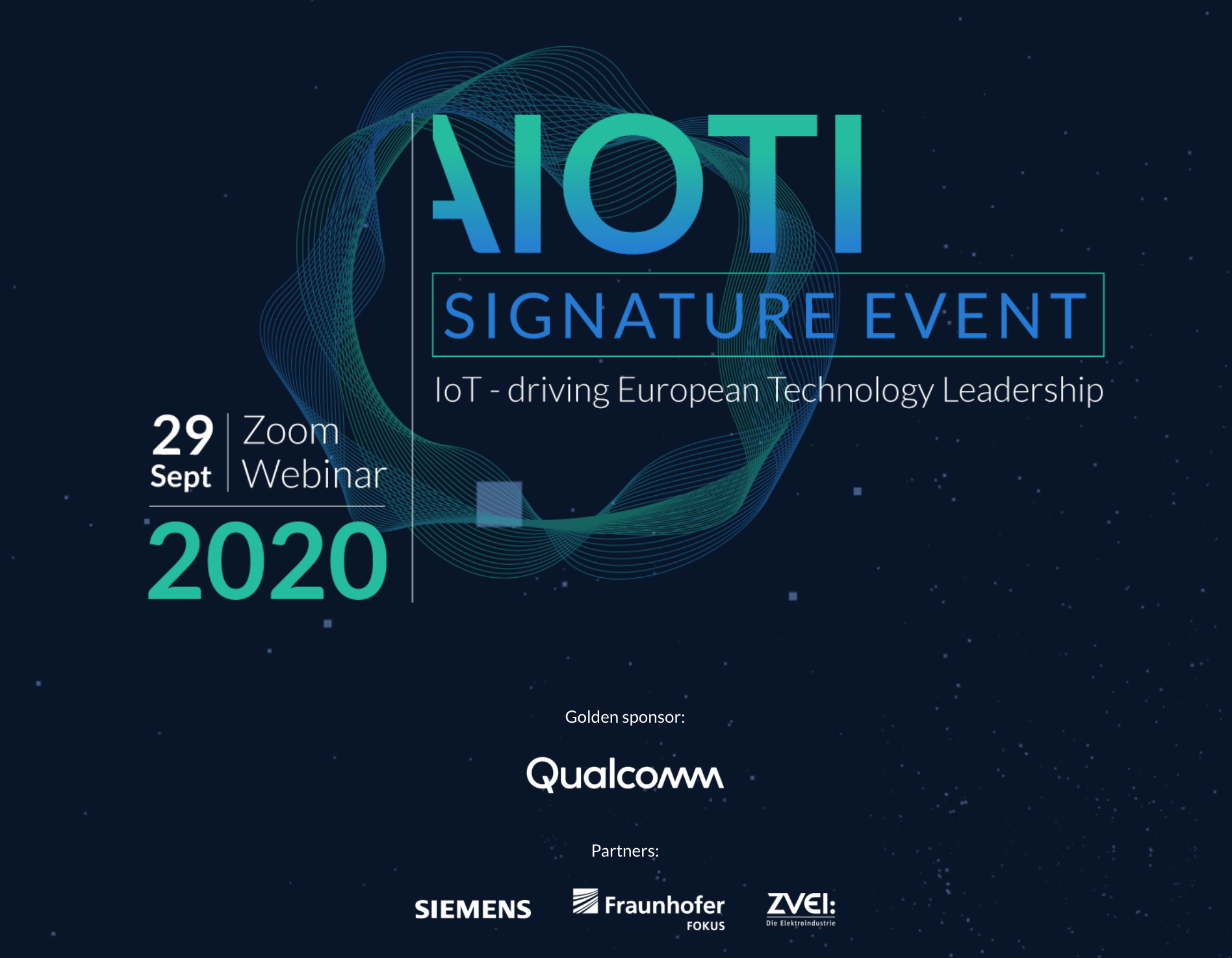
IoT/IIoT and Edge Computing convergence: how to move towards European solutions
Introduction
On the 29. September, we celebrated our 2. Signature Event, bringing together close to 250 stakeholders to discuss the new technological advances affecting the IoT ecosystem. We invited change-makers and policy-shapers to join the debate on some of the most pressing cross-domain topics, including:
- Data sovereignty and the role of IoT
- 5G and beyond: applications in cross-vertical domains
- European Research priorities for IoT, sustainability and climate change
Although this post cannot do justice to the richness and quality of the interventions, we do hope that it can serve as an aide-memoir for those of you who were able to attend, and a glimpse of what was on offer for those of you who could not.
“We are entering Europe’s Digital Decade”
The keynote speeches from Stefan Schnorr, from Federal Ministry of Economy of Germany and Pearse O’Donohue and Max Lemke from DG Connect, European Commission shared a common message of working together to secure Europe’s recovery and using the crisis to usher in Europe’s Digital Decade based on:
- Digital Sovereignty and Competitiveness, including secure storage of European Data, digital identity at device level and European data infrastructures;
- Securing an innovative European Platform and Data Economy through an effective governance framework for digital spaces and access to data for AI, regulation of digital platforms and guaranteed interoperability;
- Implementing Human-Centric Digital Transformation by promoting rules for AI that uphold European values and stimulate innovation;
- Strengthening EU Cybersecurity across technologies and domains, at device, data and communication levels.
In all of these fields, we need to act in a way that does not stymie our international competitiveness.
The Policy vision of the Commission as communicated by President Von der Leyen is based on the twin pillars of the Green deal, tackling climate change head-on and Digital Europe with at least 20% of the recovery funds allocated to this end.
“A Shift to cognitive cyber-physical systems”
The paradigm is shifting to cognitive cyber-physical systems, transitioning from cloud to the edge. The emphasis will change from consumer to businesses, particularly in sectors such as healthcare, agriculture and energy. The move to the edge has implications for hardware and microelectronics, as devices once again become critical components. The closer to the edge, the more specific the applications must be, which in turn implies greater customization of devices.
And as digital enabling technology strategies converge, we must work on holistic approaches to Data Processing, Connectivity and Intelligence. Essentially, cognitive cyber-physical systems are set to underpin the next generation of the Intelligent Internet of Things.
“The Continuum”
The “computing continuum” links IoT/edge meta-level operating systems and digital industrial platforms, enhancing performance by harnessing intelligence. Data is not just transmitted, but fused from different devices in a given neighbourhood and/or federated from far edge resources. This decentralisation is expected to have a significant impact on decarbonization, not least by reducing the processing power required to collect analyse and act on data.
“A Data Evolution, not a Data revolution”
This federation is at the heart of Gaia-X is a European industry-led initiative established to develop common requirements for a European data infrastructure and bring European rules and values to the cloud: openness, transparency, data security, privacy. The aim to not to substitute existing cloud infrastructure but to build on existing solutions, activating industry to look at real needs and define common data spaces.
With over 500 participants from 300 organisations from a myriad of different industries (Mobility, Energy, Manufacturing, Finance etc.), the work undertaken so far has confirmed that 80% of requirements are common across domains and that success is tied to applying an evolutionary rather than revolutionary approach, meeting users where they are today.
“5G: Unlocking the Potential of Industrial IoT”
With consumer and personal communication commercial 5G networks rolling out in ever-more countries, the next wave of 5G expansion is expected to allow organizations to digitalise with greater mobility, flexibility, reliability and security than ever before. 5G deployment is accelerating. One and a half years after launch there are over 80 commercially deployed networks, with a further 300 in the pipeline as 5G commercialization becomes mainstream, fuelling new applications that include those required for the factory of the future.
In this context, cross-company interoperability for operational technologies (OT) becomes mission-critical. Some potential solutions involve platforms that enable the interconnection of machinery through asset administration.
On the information technology (IT) side, data can only inform decisions if it is available at the point and time at which decisions are to be taken. Industrial data is expected to will grow five-fold to 2025 but, currently, 80% of industrial data is not collected and consequently not analysed. Experimentation is key- start fast, fail fast as there is a feedback loop in inherent in any data initiative.
Expanding 5G Industrial IoT to make the factory of the future a reality includes 5G time-sensitive networking (TSN), Ultra-high reliability with CoMP 5G precise indoor positioning (eURLLC), sub-meter 3D positioning with multi-TRP and 5G IIoT research collaborations.
“Digital alignment with Sustainable Development Goals”
Finally, “intelligent connectivity” is essential to achieve the United Nations Broadband Commission agenda for 17 Sustainable Development Goals (SDGs). Deployment targets have been set for 2025, underlining the importance of communication systems and networks in addressing economic growth, multiple social challenges, and other critical issues around climate change and sustainability.
Most of the SDGs have a positive link with digital technologies (SDG 9 – Infrastructure, industry and innovation, SDG 8 – Decent work and economic growth, SDG 3 – Health and well-being) but there may also be a downside to the use of digital in the form of e-waste due to material inefficiency, and the non-circularity of devices.
Progress is needed on energy and material efficiency (durability, reparability, recyclability). Data from satellites can be used to improve our carbon footprint and used to trigger behavioural change.
On another front, buildings are the single largest energy consumer in Europe, absorbing 40% of final energy and producing about 36% of all greenhouse emissions. 75% of buildings are considered energy inefficient, and, depending on the Member State, only 0.4-1.2% of the stock is renovated each year. But if Europe is to fulfil its 2050 climate and energy goals, this rate will need at least to double to reach 3 % per year, building on data-driven policy-making that ensures that any legislation is adapted to the geography, climatic zone etc.
Acknowledgements
A few final words: AIOTI is not just about technologies, systems of systems or platforms of platforms. We are about people, individuals who are experts in technologies, data, industries, behavioural economics and societal adoption and adaptation. It is in this spirit that we continue to embrace discussion and provide a platform through which the technological continuum can be explored.
With thanks to the following panellists who shared their expertise and visions for the future of IoT: Pearse O’Donahue, Director General DG Connect and Max Lemke, Head of Unit, DG Connect, IoT Unit, EC, Stefan Schnorr, Ministerial Director, Digital and Innovation policy, Federal Ministry of Economy, Germany; Alban Schmutz, Chairman of CISPE; Friedrich Gröteke, Federal Ministry of Economy, Germany; Dr. Dieter Wegener, Siemens, Chairman of ZVEI Industry 4.0 Management Team, Joline Jammaers, SAS, Senior Data Scientist; Torsten Küpper, Senior Director Government Affairs Europe, Qualcomm; Werner Mohr, 5G IA, Dušan Chrenek, DG Clima; Alena Siarheyeva, AIOTI, Chairperson of WG IoT Ecosystems and Innovation; Natalie Samovich, Enercoutim, Chairperson of AIOTI WG Smart Energy; Parm Raeewal, Vodafone, Chairperson of AIOTI WG Smart Building and Architecture.
AGENDA

BluSpecs, moderator of the event



BluSpecs, moderator of the event











